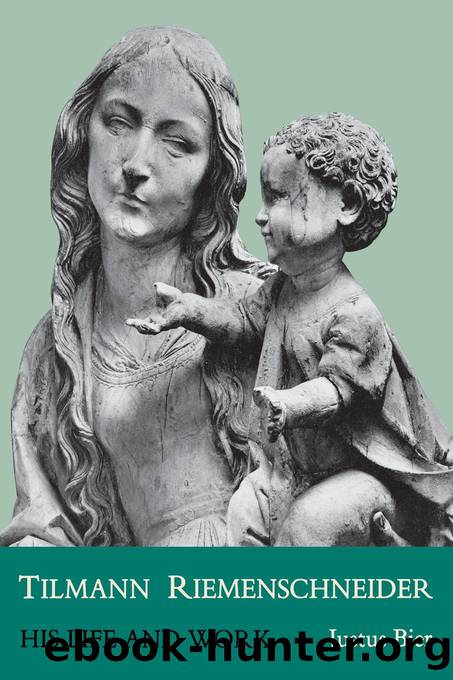Tilmann Riemenschneider by Bier Justus;

Author:Bier, Justus; [Bier, Justus]
Language: eng
Format: epub
Publisher: University Press of Kentucky
Published: 2021-08-15T00:00:00+00:00
PLATES 9A-D. St. Jerome and the Lion. About 1505â1510.
Cleveland Museum of Art, Cleveland, Ohio. Alabaster. Height 15 in. (37.8 cm).
The small alabaster group of St. Jerome and the Lion deserves to be regarded as one of Riemenschneiderâs most important works. The artistry of carving and strength of feeling achieved on such a small scale are, in their way, as remarkable as the grandiose display of these same qualities in the great Creglingen Altarpiece. The group was acquired by the Cleveland Museum in 1946 (the first of three Riemenschneider works to enter this collection). It remains the only example in a collection in the United States of Riemenschneiderâs rare use of alabaster.
Dressed in cardinalâs robes, St. Jerome is seated on a bench set on grass-covered ground, the grass indicated through shallow relief cutting and the use of green paint, of which only traces remain. (The same color appears in one of the reliefs on the Bamberg imperial tomb and on several other works in alabaster. Riemenschneider quite often used touches of color and gold to enrich the surface of his stone sculptures.) The bench is visible only from one side and from the rear. The saintâs head inclines to the left as he looks down with compassion on the docile lion sitting close to his left side. The lionâs left foreleg is held up for the saintâs surgery. With his left hand Jerome holds the leg in a firm but gentle grip: with his right, he tries delicately, by means of a âscalpel,â to extract the thorn from the injured paw. His cardinalâs hat rests on his knee, helping to keep his arm and hand steady. The fine-featured face of the saint is careworn. Deep lines are etched around his eyes and on his brow, and the spare flesh reveals wide cheek-bones, a long lean jaw, and pointed chin. The countenance as a whole not only shows the concentration and compassion of the moment but seems also to bear witness to years of an ascetic, spiritually rigorous existence.
The incident that Riemenschneider represents hereâthat of St. Jerome extracting the thorn from the lionâs pawâcomes from one of the legends told about this great scholar-saint. This incident was particularly popular with artists of the fifteenth century, who set the scene either in the saintâs study or in an open landscape representing the desert of Chalcis, where Jerome lived as a penitent and hermit for some years. A panel-painting of the second type by the Flemish artist Rogier van der Weyden, which is now in the Detroit Institute of Arts, seems to have furnished the basic model for Riemenschneiderâs sculpture. The main difference is that, while van der Weydenâs figure is seated on a rock ledge, Riemenschneider continues the tradition of showing St. Jerome âin cathedraâ and thereby characterizing him as the great Latin doctor even in the outdoor scene. Riemenschneider has also added a feature of his own invention by changing the position of the cardinalâs hat and placing it on the saintâs knee, to support his arm and steady his hand as he extracts the thorn.
Download
This site does not store any files on its server. We only index and link to content provided by other sites. Please contact the content providers to delete copyright contents if any and email us, we'll remove relevant links or contents immediately.
Technical Art History by Jehane Ragai(406)
Art, Science, and the Natural World in the Ancient Mediterranean, 300 BC to AD 100 by JOSHUA J. THOMAS(384)
Graphic Culture by Lerner Jillian;(373)
The Slavic Myths by Noah Charney(330)
Pollak's Arm by Hans von Trotha(305)
Treasuring the Gaze by Hanneke Grootenboer(305)
Simply Artificial Intelligence by Dorling Kindersley(302)
The Art of Portrait Drawing by Cuong i(295)
Drawing Landscapes by Barrington Barber(290)
Drawing for the Soul by Zoë Ingram(289)
The Art of Painting Sea Life in Watercolor by Maury Aaseng Hailey E. Herrera Louise De Masi and Ronald Pratt(276)
Sketchbook Confidential: Secrets from the private sketches of over 40 master artists by Editors of North Light Books(272)
Portrait of a Woman by Bridget Quinn(261)
Preparing Dinosaurs by Wylie Caitlin Donahue;(255)
A text-book of the history of painting by Van Dyke John Charles 1856-1932(254)
Anatomy for the Artist by Jennifer Crouch(252)
Mountain Manâs Field Guide to Grammar by Gary Spina(249)
Egyptian art by Jean Capart(246)
Botanical Illustration by Valerie Price(245)
